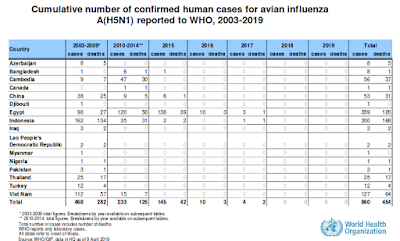#14,040
There are multiple, unconfirmed media reports that Nepal has recorded their first avian H5N1 human infection, and death. Details - such as the date of the patients death - differ between media outlets
Despite references in the media to a press release, I've found nothing on Nepal's Ministry of Health website, and the MOH's twitter account is likewise silent, with the last tweet issued on April 21st.
If confirmed, this would be the first human H5N1 infection reported anywhere in the world since September of 2017.Some headlines from Nepal, then I'll have more. First from the Himalayan Times, followed by a report from Setopati , and last from the Kathmandu Post.
First human casualty from bird flu reported in Nepal
Published: May 02, 2019 1:09 pm
KATHMANDU: Bird flu, also known as avian influenza (H5N1 influenza), has recently been determined as the cause of the death of an infected person from Kavrepalanchok district. This is the first reported avian flu casualty in the country, Ministry of Health and Population confirmed.
According to the health ministry, the 21-year-old patient whose identity has been kept under wraps, died on March 29 after having contracted the flu.
(Continue . . .)
First human fatality from bird flu in Nepal
WHO says it can't spread to people through thoroughly cooked bird meat
Kathmandu, May 2
A youth of Kavre is confirmed to have died from avian influenza, commonly known as bird flu, caused by H5N1 virus.(Continue . . .)
The cause of the 21-year-old’s death on April 8 was not known earlier. The youth, who was suffering from coughing and other problems related to breathing, had breathed his last in the course of treatment.
The saliva of the patient was sent to Japan for tests which confirmed that the youth has died from avian influenza, according to the Ministry of Health and Population.
Nepal reports first avian flu death
Kathmandu
May 2, 2019-
A man from Kavre has died due to avian flu, in the first death ever by the disease in the country, officials at the Ministry of Health said on Thursday.
The 21-year-old man, who had received medication for influenza after he was taken to the hospital for fever and cough, died on March 29, the ministry said.After the type of virus could not be confirmed in the country, samples were sent to Japan for confirmation.
“Tests from the Japanese laboratory confirmed that the person was infected with influenza A (H5N1),” the ministry said in a press statement.
(Continue . . . )
Despite hundred of H5N1 poultry outbreaks across India and Nepal over the past dozen years, human infections have never been reported from either nation. Neighboring Bangladesh, however, has reported 8 (mostly mild) cases, and 1 death.
The H5N1 virus (like all other flu viruses) continues to evolve (see Eurosurveillance: Emergence Of A Novel Cluster of H5N1 Clade 2.2.1. 2 and V. Sinica: HPAI H5N1 Clade 2.3.2.1c Virus in Migratory Birds, 2014–2015) and continues to increase in diversity around the globe (see chart below).
Differences in virulence and transmissibility exist between these clades, subclades, and genotypes - and that may help explain some of the difference in impacts we've seen over time, and around the world (see Differences In Virulence Between Closely Related H5N1 Strains).
While we await WHO confirmation of this case, it is worth mentioning that Nepal - with limited medical resources - continues to deal with what has been described as an unusually heavy flu season.
From National Geographic two days ago:
Flu outbreak rages near Everest base camp
Local doctors worry remote Nepal region is primed for a flu epidemic


